2003 CHEVROLET AVALANCHE DIC
[x] Cancel search: DICPage 1 of 492

Seats and Restraint Systems........................... 1-1
Front Seats
............................................... 1-2
Rear Seats
............................................... 1-8
Safety Belts
.............................................1-10
Child Restraints
.......................................1-32
Air Bag Systems
......................................1-52
Restraint System Check
............................1-67
Features and Controls..................................... 2-1
Keys
........................................................ 2-3
Doors and Locks
....................................... 2-7
Windows
.................................................2-23
Theft-Deterrent Systems
............................2-25
Starting and Operating Your Vehicle
...........2-27
Mirrors
....................................................2-46
OnStar
žSystem
......................................2-53
HomeLinkžTransmitter
.............................2-55
Storage Areas
.........................................2-59
Sunroof
..................................................2-84
Vehicle Personalization
.............................2-85
Instrument Panel............................................. 3-1
Instrument Panel Overview
.......................... 3-4
Climate Controls
......................................3-20
Warning Lights, Gages and Indicators
.........3-30
Driver Information Center (DIC)
..................3-46
Audio System(s)
.......................................3-64Driving Your Vehicle....................................... 4-1
Your Driving, the Road, and Your Vehicle
..... 4-2
Towing
...................................................4-48
Service and Appearance Care.......................... 5-1
Service
..................................................... 5-3
Fuel
......................................................... 5-5
Checking Things Under the Hood
...............5-10
Rear Axle
...............................................5-49
Four-Wheel Drive
.....................................5-50
Front Axle
...............................................5-51
Bulb Replacement
....................................5-52
Windshield Wiper Blade Replacement
.........5-60
Tires
......................................................5-61
Appearance Care
.....................................5-88
Vehicle Identi®cation
.................................5-96
Electrical System
......................................5-96
Capacities and Speci®cations
...................5-106
Normal Maintenance Replacement Parts
....5-108
Maintenance Schedule..................................... 6-1
Maintenance Schedule
................................ 6-2
Customer Assistance Information.................... 7-1
Customer Assistance Information
.................. 7-2
Reporting Safety Defects
...........................7-10
Index................................................................ 1
2003 Chevrolet Avalanche Owner ManualM
Page 4 of 492

Vehicle Damage Warnings
Also, in this book you will ®nd these notices:
Notice:These mean there is something that could
damage your vehicle.
A notice will tell you about something that can damage
your vehicle. Many times, this damage would not be
covered by your warranty, and it could be costly. But the
notice will tell you what to do to help avoid the
damage.
When you read other manuals, you might see CAUTION
and NOTICE warnings in different colors or in different
words.
You'll also see warning labels on your vehicle. They use
the same words, CAUTION or NOTICE.
Vehicle Symbols
Your vehicle has components and labels that use
symbols instead of text. Symbols, used on your vehicle,
are shown along with the text describing the operation
or information relating to a speci®c component, control,
message, gage or indicator.
If you need help ®guring out a speci®c name of a
component, gage or indicator, reference the following
topics:
·Seats and Restraint Systems in Section 1
·Features and Controls in Section 2
·Instrument Panel Overview in Section 3
·Climate Controls in Section 3
·Warning Lights, Gages and Indicators in Section 3
·Audio System(s) in Section 3
·Engine Compartment Overview in Section 5
iv
Page 10 of 492
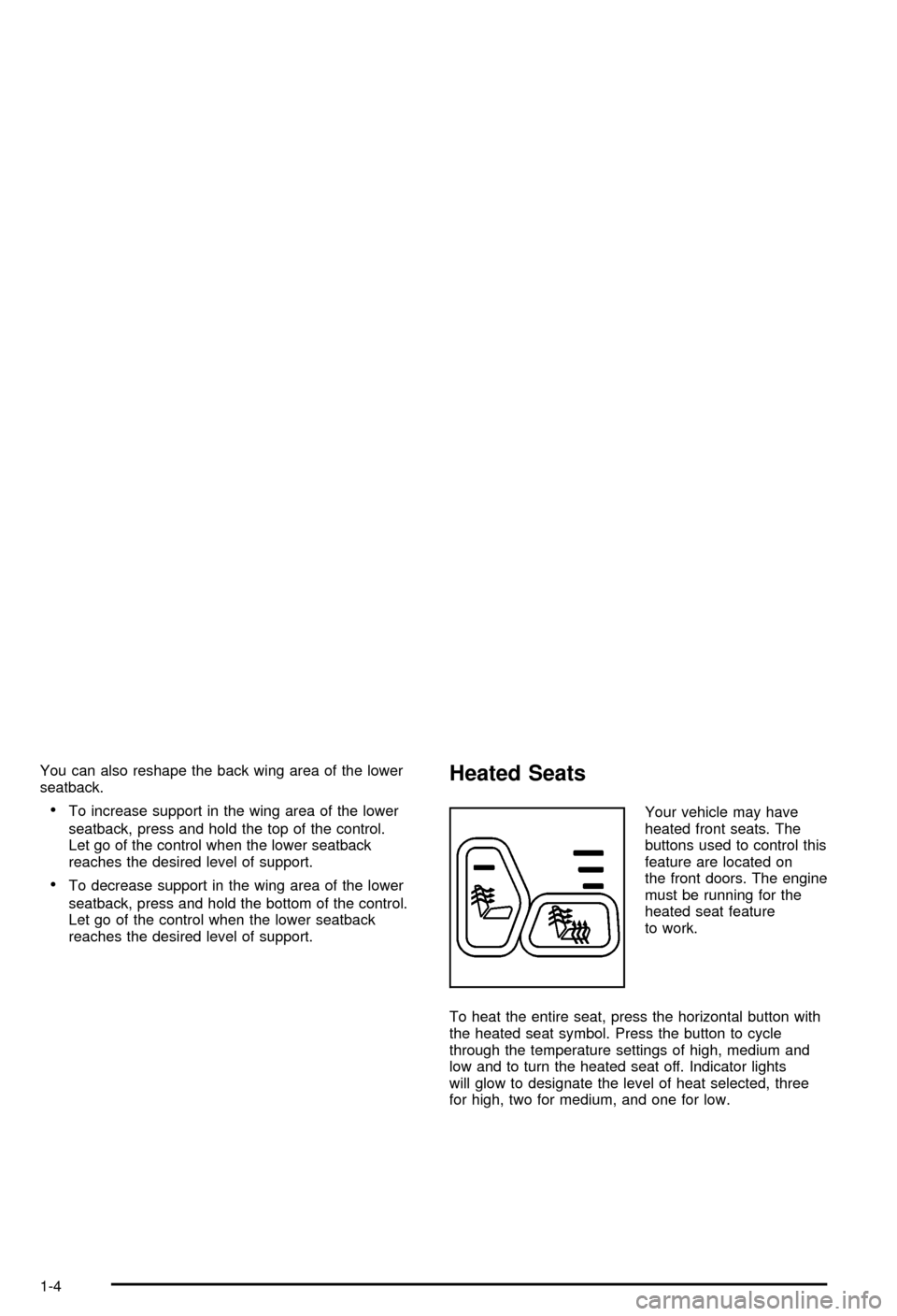
You can also reshape the back wing area of the lower
seatback.
·To increase support in the wing area of the lower
seatback, press and hold the top of the control.
Let go of the control when the lower seatback
reaches the desired level of support.
·To decrease support in the wing area of the lower
seatback, press and hold the bottom of the control.
Let go of the control when the lower seatback
reaches the desired level of support.
Heated Seats
Your vehicle may have
heated front seats. The
buttons used to control this
feature are located on
the front doors. The engine
must be running for the
heated seat feature
to work.
To heat the entire seat, press the horizontal button with
the heated seat symbol. Press the button to cycle
through the temperature settings of high, medium and
low and to turn the heated seat off. Indicator lights
will glow to designate the level of heat selected, three
for high, two for medium, and one for low.
1-4
Page 11 of 492
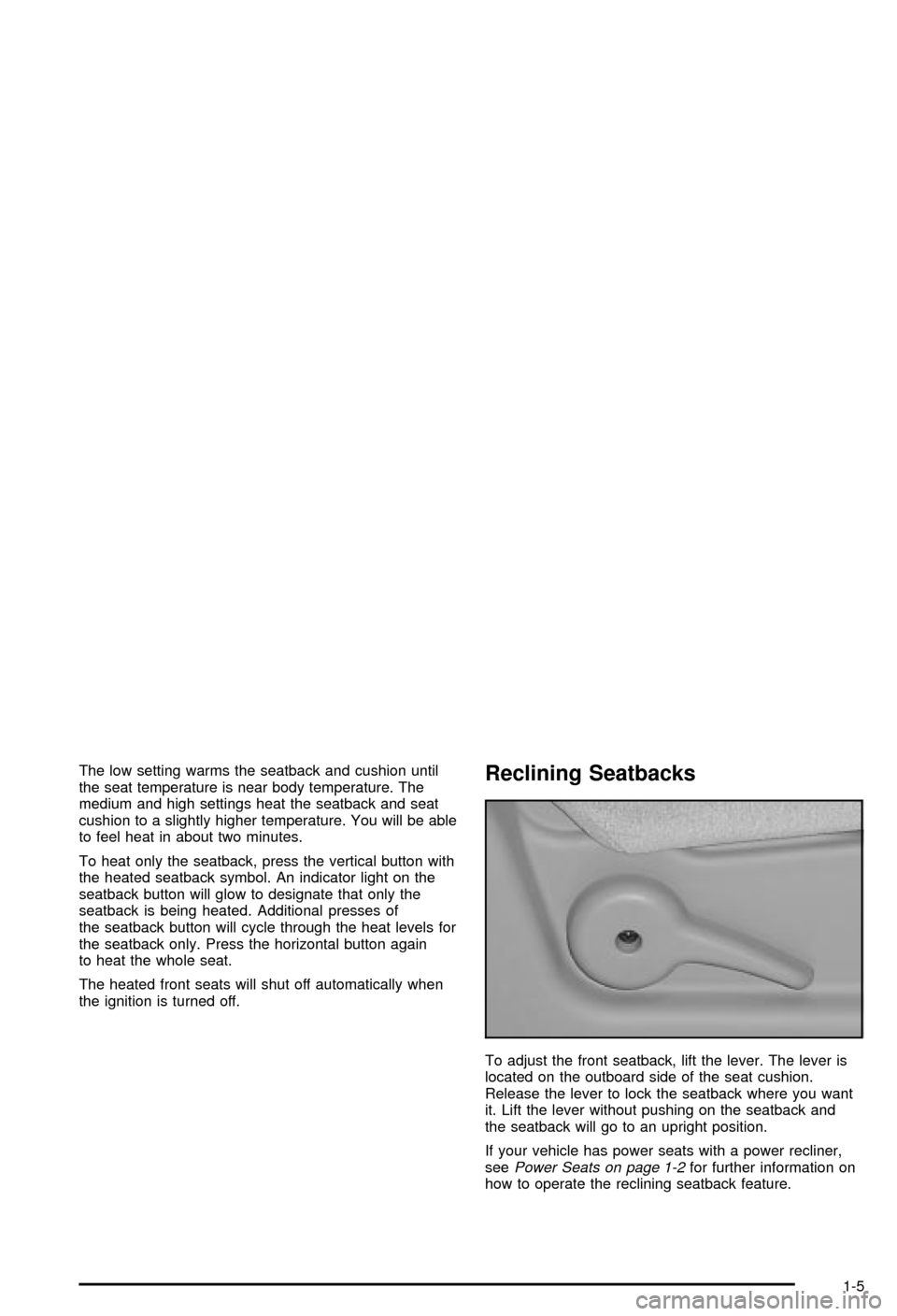
The low setting warms the seatback and cushion until
the seat temperature is near body temperature. The
medium and high settings heat the seatback and seat
cushion to a slightly higher temperature. You will be able
to feel heat in about two minutes.
To heat only the seatback, press the vertical button with
the heated seatback symbol. An indicator light on the
seatback button will glow to designate that only the
seatback is being heated. Additional presses of
the seatback button will cycle through the heat levels for
the seatback only. Press the horizontal button again
to heat the whole seat.
The heated front seats will shut off automatically when
the ignition is turned off.Reclining Seatbacks
To adjust the front seatback, lift the lever. The lever is
located on the outboard side of the seat cushion.
Release the lever to lock the seatback where you want
it. Lift the lever without pushing on the seatback and
the seatback will go to an upright position.
If your vehicle has power seats with a power recliner,
see
Power Seats on page 1-2for further information on
how to operate the reclining seatback feature.
1-5
Page 47 of 492
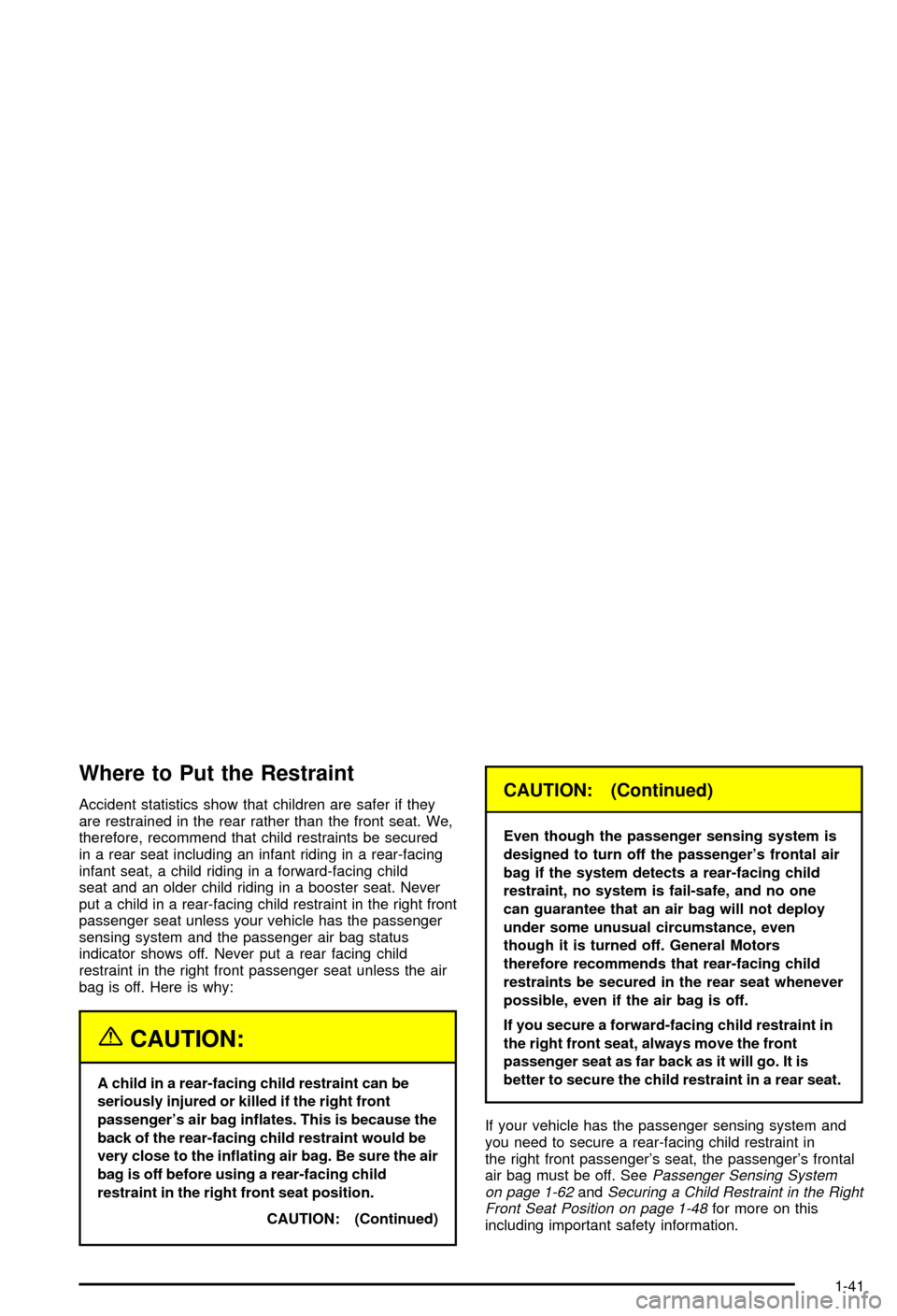
Where to Put the Restraint
Accident statistics show that children are safer if they
are restrained in the rear rather than the front seat. We,
therefore, recommend that child restraints be secured
in a rear seat including an infant riding in a rear-facing
infant seat, a child riding in a forward-facing child
seat and an older child riding in a booster seat. Never
put a child in a rear-facing child restraint in the right front
passenger seat unless your vehicle has the passenger
sensing system and the passenger air bag status
indicator shows off. Never put a rear facing child
restraint in the right front passenger seat unless the air
bag is off. Here is why:
{CAUTION:
A child in a rear-facing child restraint can be
seriously injured or killed if the right front
passenger's air bag in¯ates. This is because the
back of the rear-facing child restraint would be
very close to the in¯ating air bag. Be sure the air
bag is off before using a rear-facing child
restraint in the right front seat position.
CAUTION: (Continued)
CAUTION: (Continued)
Even though the passenger sensing system is
designed to turn off the passenger's frontal air
bag if the system detects a rear-facing child
restraint, no system is fail-safe, and no one
can guarantee that an air bag will not deploy
under some unusual circumstance, even
though it is turned off. General Motors
therefore recommends that rear-facing child
restraints be secured in the rear seat whenever
possible, even if the air bag is off.
If you secure a forward-facing child restraint in
the right front seat, always move the front
passenger seat as far back as it will go. It is
better to secure the child restraint in a rear seat.
If your vehicle has the passenger sensing system and
you need to secure a rear-facing child restraint in
the right front passenger's seat, the passenger's frontal
air bag must be off. See
Passenger Sensing System
on page 1-62andSecuring a Child Restraint in the Right
Front Seat Position on page 1-48for more on this
including important safety information.
1-41
Page 55 of 492
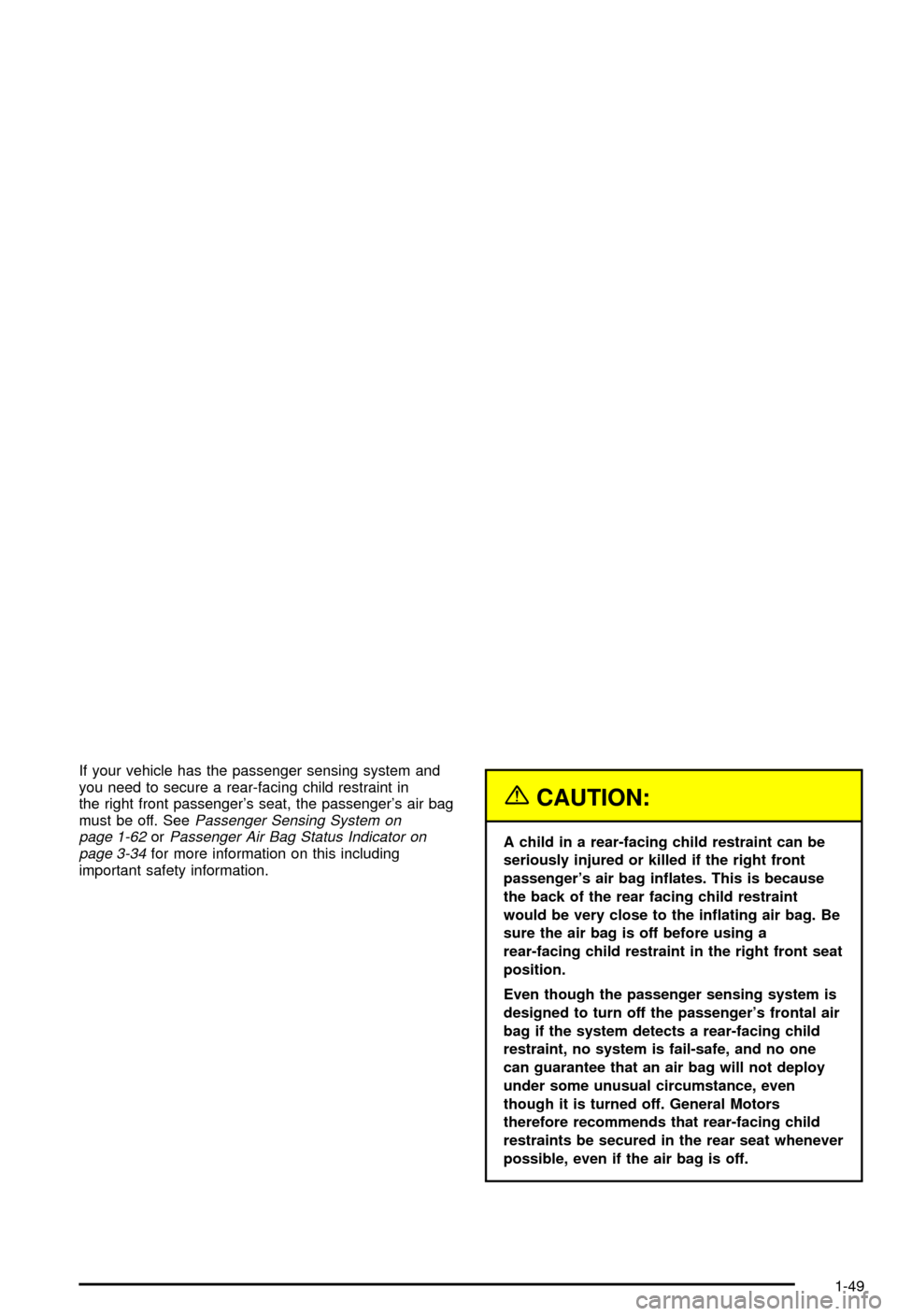
If your vehicle has the passenger sensing system and
you need to secure a rear-facing child restraint in
the right front passenger's seat, the passenger's air bag
must be off. See
Passenger Sensing System on
page 1-62orPassenger Air Bag Status Indicator on
page 3-34for more information on this including
important safety information.
{CAUTION:
A child in a rear-facing child restraint can be
seriously injured or killed if the right front
passenger's air bag in¯ates. This is because
the back of the rear facing child restraint
would be very close to the in¯ating air bag. Be
sure the air bag is off before using a
rear-facing child restraint in the right front seat
position.
Even though the passenger sensing system is
designed to turn off the passenger's frontal air
bag if the system detects a rear-facing child
restraint, no system is fail-safe, and no one
can guarantee that an air bag will not deploy
under some unusual circumstance, even
though it is turned off. General Motors
therefore recommends that rear-facing child
restraints be secured in the rear seat whenever
possible, even if the air bag is off.
1-49
Page 56 of 492
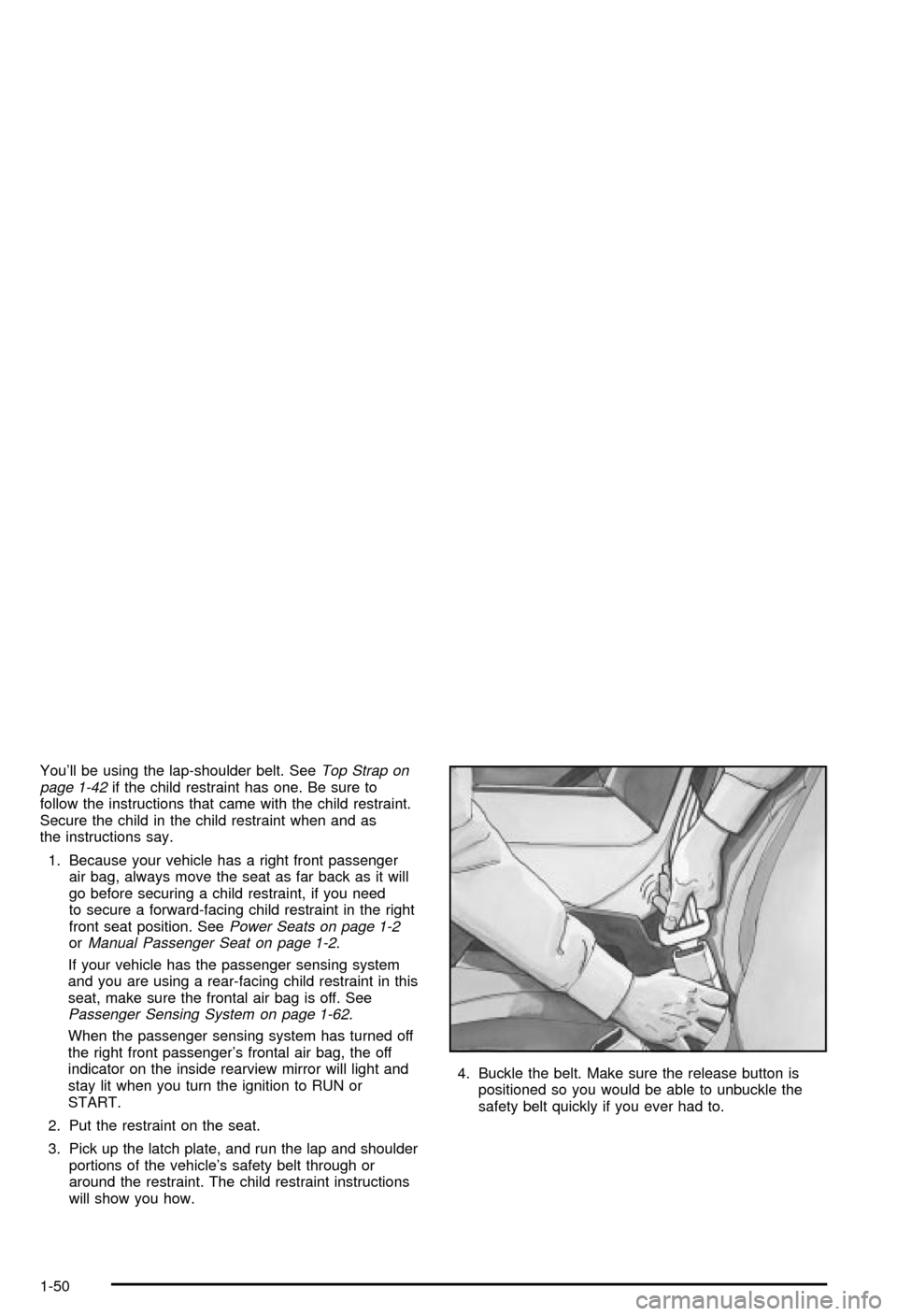
You'll be using the lap-shoulder belt. SeeTop Strap on
page 1-42if the child restraint has one. Be sure to
follow the instructions that came with the child restraint.
Secure the child in the child restraint when and as
the instructions say.
1. Because your vehicle has a right front passenger
air bag, always move the seat as far back as it will
go before securing a child restraint, if you need
to secure a forward-facing child restraint in the right
front seat position. See
Power Seats on page 1-2orManual Passenger Seat on page 1-2.
If your vehicle has the passenger sensing system
and you are using a rear-facing child restraint in this
seat, make sure the frontal air bag is off. See
Passenger Sensing System on page 1-62.
When the passenger sensing system has turned off
the right front passenger's frontal air bag, the off
indicator on the inside rearview mirror will light and
stay lit when you turn the ignition to RUN or
START.
2. Put the restraint on the seat.
3. Pick up the latch plate, and run the lap and shoulder
portions of the vehicle's safety belt through or
around the restraint. The child restraint instructions
will show you how.4. Buckle the belt. Make sure the release button is
positioned so you would be able to unbuckle the
safety belt quickly if you ever had to.
1-50
Page 58 of 492

8. If your vehicle has the passenger sensing system
and you're using a rear-facing child restraint in this
seat, check to be sure the right front passenger's
frontal air bag is off before you begin to drive. If the
air bag has been turned off the off indicator will
light and stay lit when the key is turned to RUN or
START.
If the on indicator is lit, the passenger's frontal air
bag has not been turned off. If this ever happens,
turn the vehicle off, unbuckle the safety belt
and perform the steps to install the rear-facing
restraint again. After restarting the vehicle, if the air
bag still doesn't turn off, install the infant restraint
in a rear seat position of the vehicle and have your
vehicle serviced as soon as possible.
To remove the child restraint, just unbuckle the vehicle's
safety belt and let it go back all the way. The safety
belt will move freely again and be ready to work for an
adult or larger child passenger.Air Bag Systems
This part explains the frontal and side impact air bag
systems.
Your vehicle has air bags ± a frontal air bag for the
driver and another frontal air bag for the right front
passenger. Your vehicle may also have a side impact
air bag. Side impact air bags are available for the driver
and right front passenger.
If your vehicle has a side impact air bag for the driver
and/or the right front passenger, the words AIR BAG will
appear on the air bag covering on the side of the
seatback closest to the door.
1-52